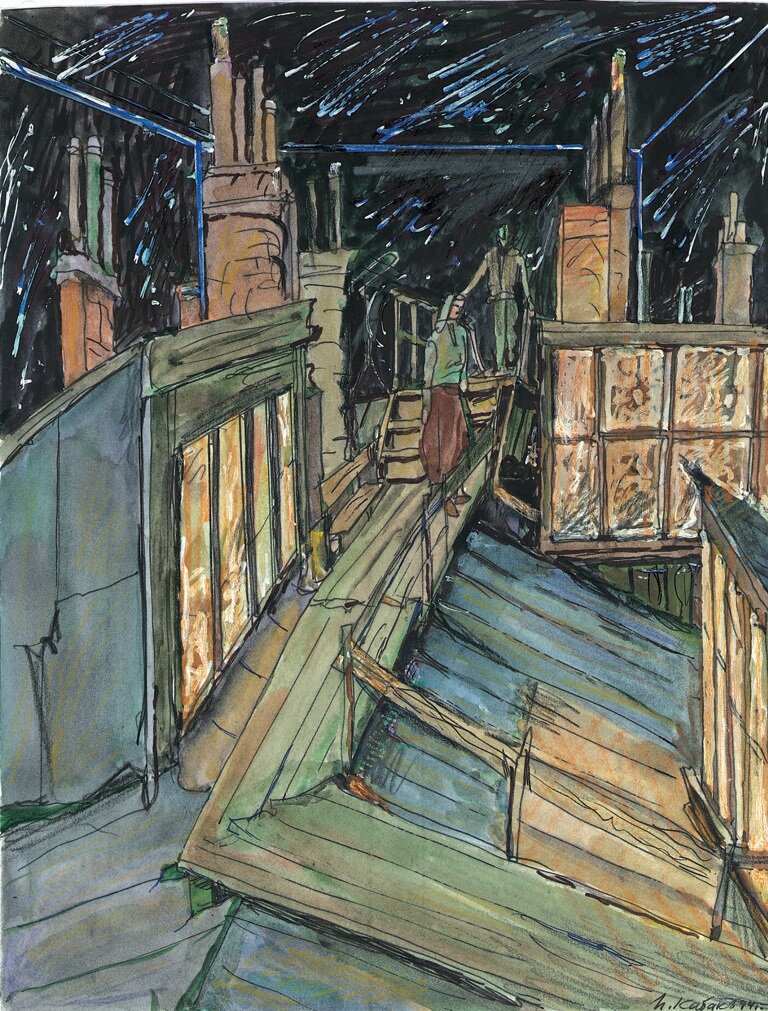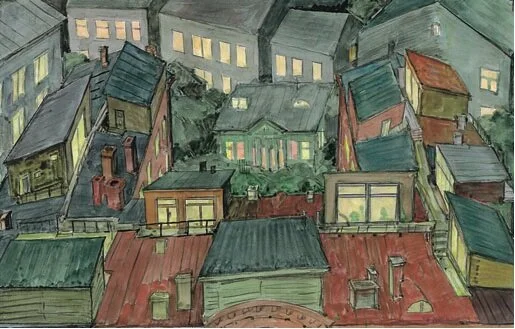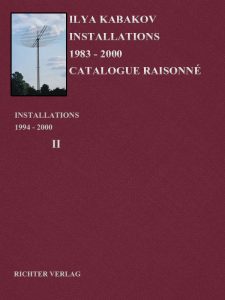On the Roof
YEAR: 1996
CATALOG NUMBER: 100
PROVENANCE
Collection of the artist
Not preserved
EXHIBITIONS
Brussels, Palais des Beaux-Arts de Bruxelles
Ilya Kabakov. Sur le Toit / Op Het Dak, 7 Jun 1996 — 8 Sep 1996
DESCRIPTION AND CONCEPT OF THE INSTALLATION
The viewer enters through a door, moving aside a curtain which covers it, and immediately finds himself … on the roof. It is possible to ascend and move forward only via a special wooden plank with barriers running along the sides. To the right and left of it are the slopes of ‘roofs,’ while moving forward one must walk around large and small chimneys rising up on both sides.
Night surrounds the viewer, but his path and the roofs are illuminated by a light coming from the right and left from large and small windows of apartments and rooms located on the top floors of this building. The windows are positioned as is usually the case on rooftops, at the same level as the passing viewer who can easily glance into each of them and see what is going on inside.
There are 10 such places in the installation, i.e., rooms jutting above the level of the roof, and not only can the viewer see what is going on there, but if he is interested in this activity he can enter the rooms, since there is a door leading from each one of them onto the roof.
In the very first room the viewer sees a lighted screen through the window, and descending down the steps and entering inside, he finds the following scene: there are 5-8 chairs in front of the screen in the shape of an amphitheater, and behind them on a little table stands a projector which is producing a slide show on the screen, slide after slide. Commentary in either a male or female voice accompanies this showing. What kind of slideshow is this that the visitor sees, and what is the narrative about?
But first a few words about the room where the viewer finds himself. It is a residential room where, apparently, a family of average means lives. Ordinary, ‘bourgeois’ furniture is all around: a wardrobe, a dining table and a desk, an old-fashioned couch, a wall unit with books, beds … Everything is old, it has already ‘lived’ … Thanks to all of this, an entirely lived-in atmosphere of an ‘ordinary’ family is created.
The slides show a program from the life of this ‘family.’ If you sit down for a little while on one of the chairs, you see before you a ‘family viewing’ that is familiar to everyone: what is shown is the life of this family – its episodes are not particularly noteworthy, but they are interesting for the family that lives here and for the invited guests. The viewer of the installation has simply ‘come upon’ something which has nothing to do with him at all.
The voice that can be heard in the room is commenting on every slide, as is customary in such situations, recounting some sweet but not particularly interesting details about those people who are on the screen at that moment.
The viewer once again exits onto the ‘roof’ and moves toward the next such room, where he finds almost the same situation: again there is a screen, chairs before him, a voice commenting on the events that this time happened to other people, there are other faces on the screen, the events are occurring in other places. The viewer can submerge into this show and listen to the voice, but then again he moves on to the next window, where virtually the same scene is repeated with minor changes …
… But it is not entirely the same situation. In the third installation, the viewer notices that there is a unique kind of ‘plot’ development from one installation to another. The plots of each one progress through time. In the first one, the plot concerns the beginning of life, the story of a baby, his first years. In the second, the story is about older children, there are memories of school, of school studies, of school games. In the third one, the story is of youth, about first dates …
All of the installations, to the last one, to the ninth room, form an entire cycle of life, wherein the last one there is old age, illness and death. In each room, there are various ‘figures,’ various fates and circumstances, but the overall sense of everything is that of the life of a ‘simple,’ ordinary person from beginning to end.
… In the center of the installation is the largest room – a re-creation of the artist’s studio in Moscow. The slides show daily life in this studio, the ‘voice’ provides commentary on it. In this way, both documentary and fabricated materials participate simultaneously in the entire installation as a whole.
A special ‘role’ in the installation is given to the viewer himself, a ‘sound’ role, although he doesn’t have to do anything in particular for this. The path, the plank along which he moves across the roof, is covered with old tin and when he steps on it, it creates the very same metallic thunder that we hear when someone is walking on the roof above us. And so, at the moment when one viewer, sitting below, is looking at the slides and listening to the commentary, all of this takes place against the background of the noise of footsteps generated by other viewers who are passing by. This background is precisely that mandatory ‘social’ component which conveys a special drama to this entire event of the showing of slides, chamberlike and intimate in its meaning, imparting to the entire idea a certain symbolic quality.
There is a specific metaphor contained in the position of the viewer as well. He, the viewer, is either a complete outsider vis-a-vis the fate of the people inside the room – he is a ‘person from the roof’ – or, on the other hand, dropping into any one of these rooms, submerging himself into an ordinary ‘family’ story, he understands that this is also ‘about him,’ and he understands that he experienced the same things in his life, that he is just the same as ‘they’ are, the same as everybody else …
The concept of the installation includes the construction of ten rooms which the viewer can enter one after another, according to their number, beginning with the one closest to the entrance. The plots occurring in each of them are arranged in the same sequence. It’s as though they form two unconnected lines, a male plot line and a female plotline, beginning with their childhood wherein lies their common fate. But soon thereafter these lifelines, ‘his’ and ‘hers,’ diverge, and run in different directions. Here is a list, very approximate, of the plots developing in the displays of the slides recollections.
Childhood.
School.
Her institute.
His institute.
His adult life.
Her adult life.
Her environment.
His mama.
Her grandmother.
And again, childhood, her children and his child who virtually don’t know one another. The installation is ‘linearly directed,’ i.e., it has an entrance in one place and an exit at the other end.
Voices in the Installation (selection)
Room 1 Childhood ( female voice)
This is when I was two years old: my father put me in the bag and I was just sitting there. But I can’t remember why I’m holding a chicken leg between my teeth. Either I wouldn’t give up the leg on purpose, or maybe they gave it to me after I was already sitting in the bag so it would be funnier?
I’m probably a year old here. Grandmother made this knit top for me. And she put a pocket on the side so I could put things there. She made the pants long, so there would be ‘room to grow.’ I remember that chair well – it used to be in the kitchen between the table and the cupboard, which was just as old as the chair. They were already old when they were bought.
That’s me in our Gorky Park. To the left, you can’t see it here, is a large fountain squirting from a lion’s mouth, and five other little fountains of fat fish. I’m holding chamomile in my hands, there was a big scandal because of it. The park guard ran up and demanded we pay a fine.
This is our whole group in the courtyard of our building. Our house is on the left. On the right is a small cherry orchard, then a shed where the cow lived. Grandfather used to milk her for the first time at 5 a.m. and would bring me warm milk to drink. Farther on is the pole that Pavlik climbed and fell from. Then, behind the pole, is the outhouse in the yard, in the far corner beyond the path.
The kindergarten on Boikaya Street where Tolya went. The poles and skis were enormous, the poles were taller than each of us, and everyone’s in galoshes – everyone wore galoshes. Long coats, tights, collars definitely turned up, scarves around the neck to keep from catching cold – but the fact that it would be hot skiing – no one thought about that … True, no one could ‘run’ on such logs, and could move their legs only with great difficulty …
This is also in the courtyard of our building. We were playing ‘hide-and-seek’ then they called us and took a picture of us all together. It was easy to hide in our courtyard. You could crawl into the cowshed, there were lots of different storerooms, doors and fences. Sonya once hid in the outhouse and almost fell in, some of the boards were rotten. The rules were we couldn’t run out into the street.
Images
Literature







